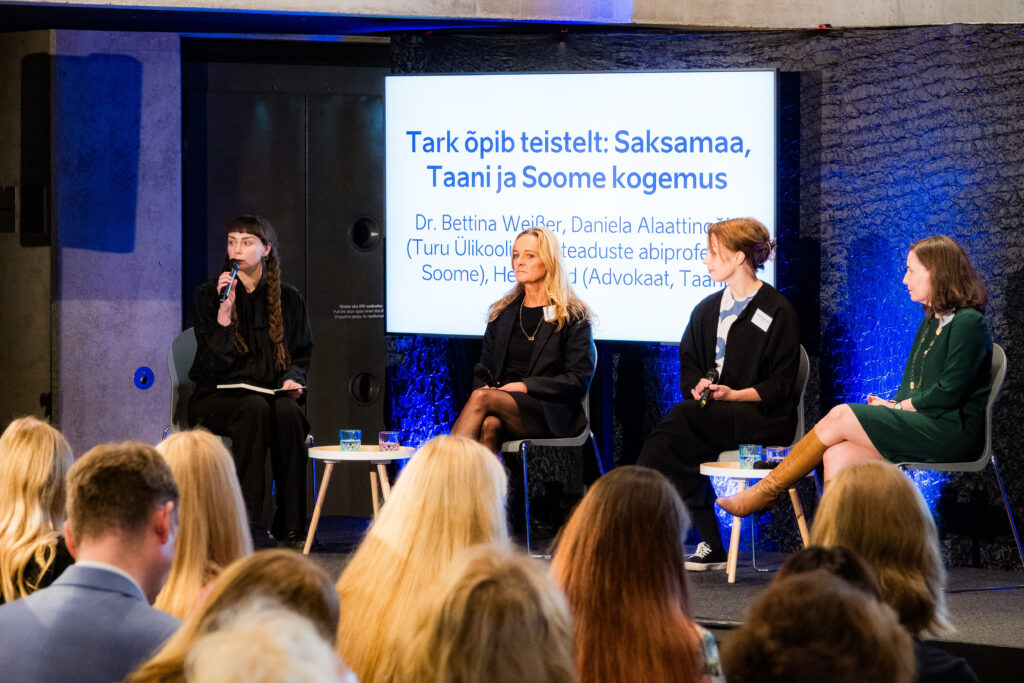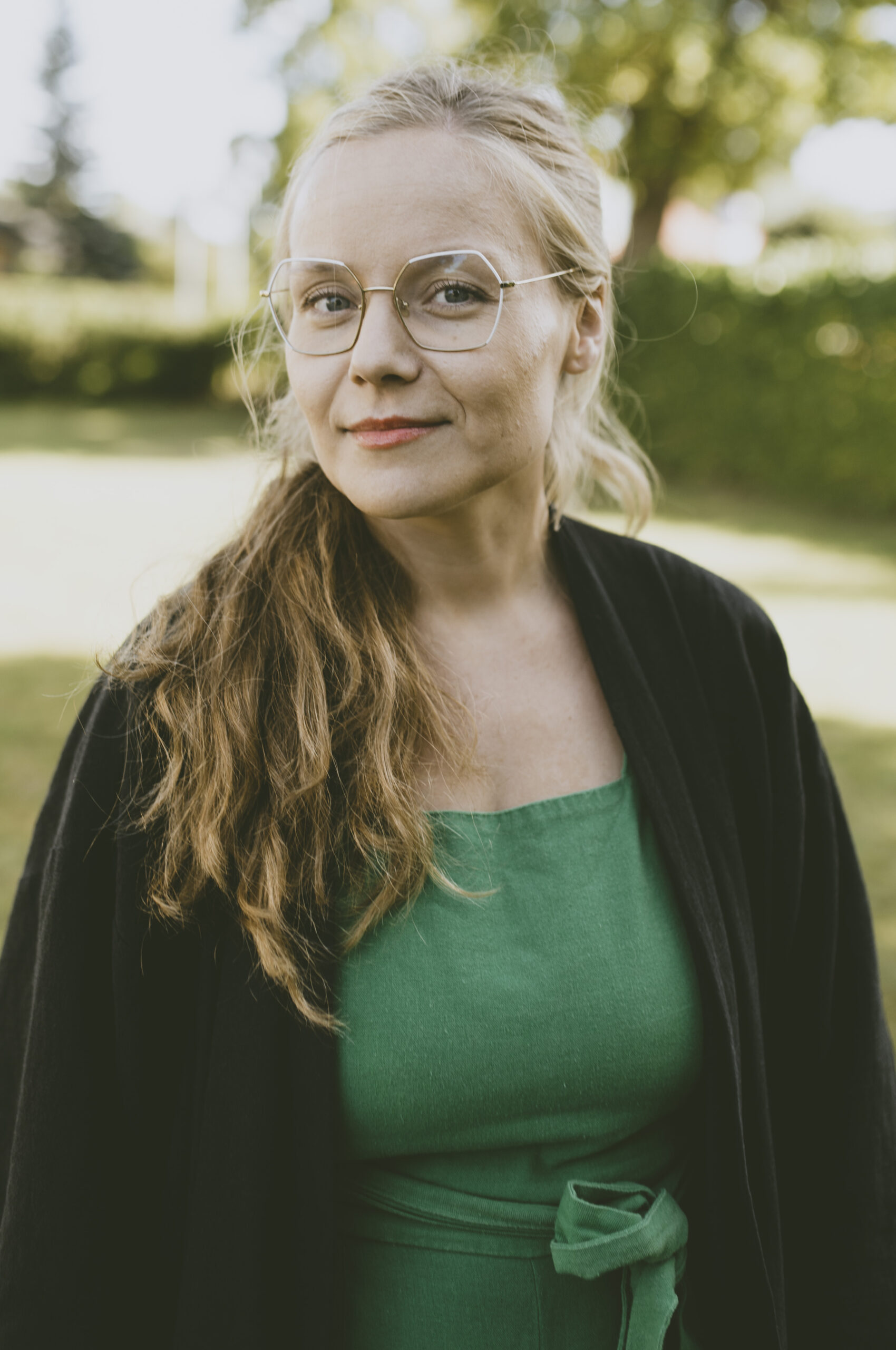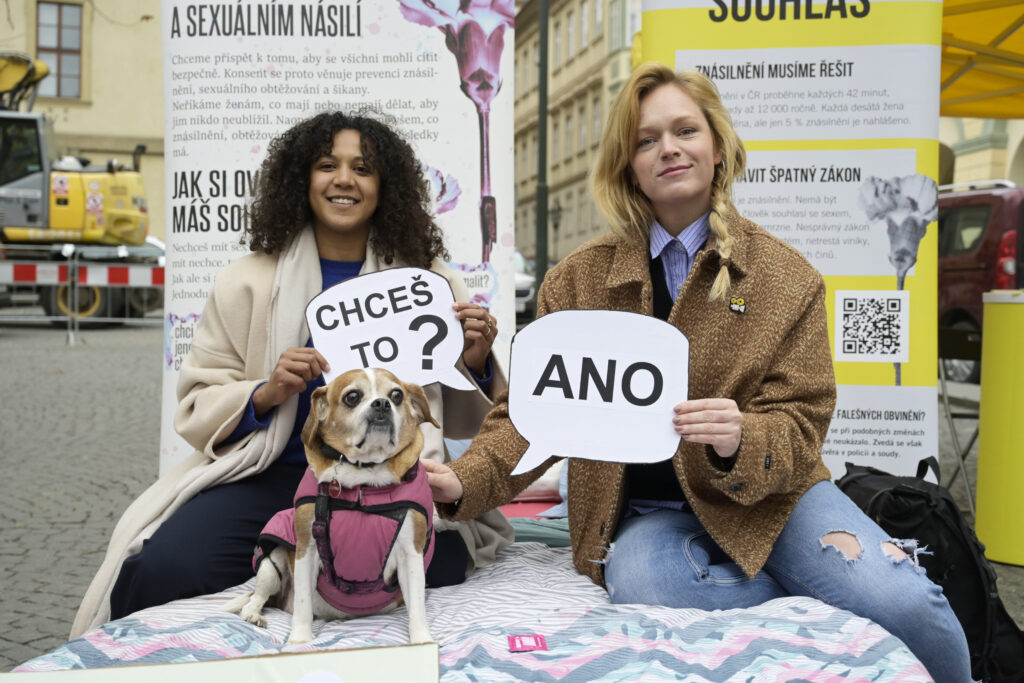Estonia needs the „Yes Means Yes“ model of affirmative consent. A report from the President Kaljulaid Foundation’s Tallinn Consent Law Forum
President Kaljulaid Foundation’s Tallinn Consent Law Forum in Tallinn on October 2nd was attended by experts from the justice and health care systems, as well as on civil society, from Estonia, Finland, Denmark, Czechia, Sweden and Germany. The main topic at the Forum was the consent law, with a focus on legal, medical and cultural perspectives. Below is a report from the Forum by Greta Roosaar, publisher of the social media site Taskufeminist.
The first to enter the Forum stage was the executive director of President Kaljulaid Foundation Taavi Linnamäe, who emphasized the importance of discussing complicated and uncomfortable subjects. Linnamäe opined that everything associated with sexual violence is a dark corner in Estonian society, and expressed hope that the assembled Forum can shed some light on it.
According to Linnamäe, Estonia has already acknowledged the urgency of the problem by ratifying the Istanbul Convention, the decision to pass the law has in principle been made, and now the process must be continued in order to determine the model for the law most suitable for Estonia. Moreover, Linnamäe stressed the need for addressing and shaping the societal attitudes that, in addition to the law itself, could further minimize sexual violence. Annika Arras, the moderator of the event, also expressed hope that the Forum would become a starting point for an important societal discussion.
Arras pointed out that every victim, irrespective of their gender, age and sexual orientation, needs protection. According to her, the current judicial system carries the risk of revictimizing those who have suffered from sexual violence, as the manner in which they are now being treated is far from dignified. Arras expressed the opinion that Estonia needs to agree on defining unconsenting sex as rape.
Survivors of sexual violence are the ones most in need of support
The Forum was framed by President Kersti Kaljulaid’s pre-recorded conversations with Estonian specialists who encounter the issue of the consent law in one way or another in their work. The first such overview focused on the victims of sexual violence, asking the question whether the state is providing them with sufficient help and support. President Kaljulaid talked with the Pelgulinna maternity hospital midwife Marina Sidorova, who does the initial checkups and provides support to those who have fallen victim to sexual attacks, and with the former prosecutor Toomas Liiva, who handled many cases of rape during his career. Both conversations highlighted the idea of time criticality – the sooner the survivor admits to a hospital’s special sexual abuse center (SAC), the greater the probability that the medical checkup will reveal evidence that will be usable in the court. The center of gravity of the conversation seemed to be the notion of support; the speakers insisted that in order for the crime to be followed by legal consequences, both emotional support and empathy as well as governmental backing are needed.
A wise person learns from the mistakes of others
Throughout the day, several specialists who have in some way been involved with the consent law in their home countries shared the experience of those countries – Bettina Weißer, director of the Institute for Foreign and International Criminal Law at the University of Cologne from Germany, Daniela Alaattinoğlu, assistant law professor at the University of Turku (who, in addition to Finland, has monitored the process of passing consent laws also in Sweden and Iceland) from Finland, Anna Möller, researcher and gynecologist at the Karolinska Institute’s Women’s Clinic in Stockholm from Sweden, Johanna Nejedlova, an activist, a founder and the head of the organization Konsent from Czechia. Several participants came from Denmark – Helle Hald, a renowned lawyer, who for more than 25 years has dedicated herself to protecting the victims of various crimes, the didactical writer on sexual education and director of the Danish Family Planning Association Anne Wind, and clinical psychologist Line Eiby and anthropologist Aviaja Mose Wingender, researchers at the Centre for Victims of Sexual Assault at Copenhagen’s Rigshospitalet.
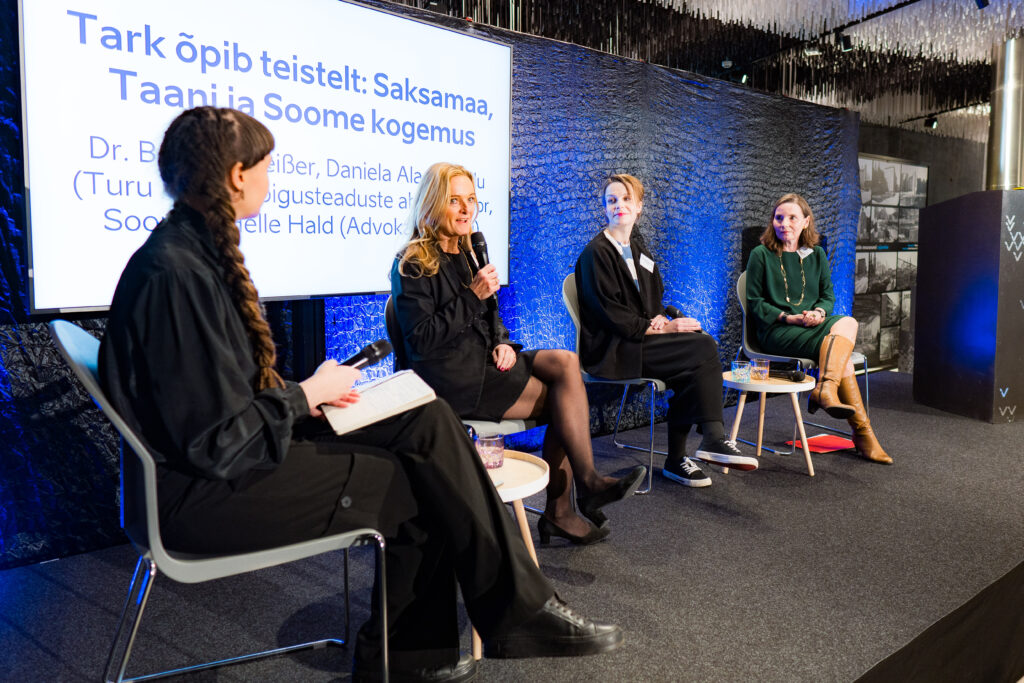
On the stage (from the left) Feministeerium’s advocacy specialist Elise Rohtmets, victim’s attorney Helle Hald from Denmark, University of Turku Assistant Professor of Law Daniela Alaattinoğlu from Finland and University of Cologne’s Director of the Institute for Foreign and International Criminal Law Bettina Weißer from Germany. Photo: Mattias Tammet
Participants described the former laws pertaining to rape in their home countries as quite similar to the ones currently in effect in Estonia – a criminal act assumes that the attacker used violence and/or threats, or took advantage of the victim’s state of powerlessness (i.e., unconsciousness). By now, all of the countries represented at the Forum have passed a new law that is in accordance with the Istanbul Convention – Germany did this in 2016, with others following successively. Different countries have adopted different models: Germany and Czechia have introduced the so-called “No Means No” model, while Sweden, Finland, and Denmark (as well as Iceland) have adopted the “Yes Means Yes” model.
To put it simply, in the No Means No model, the representative of the victim must prove in court that the victim said no (or was in a state of powerlessness), while in the Yes Means Yes model they have to prove that the victim gave no consent to the act that transpired. When the participants were asked which of the models they believed to be more effective, representatives from the countries that had adopted the Yes Means Yes model were firmly in support of it; similar support was expressed by the representative of Czechia, whose country has chosen a different path. The representative of Germany remained mostly neutral, saying she believed that the new law was definitely better, since it corrected several flaws in the old law, while also pointing out that she had not come to the stage as a spokesperson for the No Means No model.
It takes more than laws alone to change the mentality
While otherwise the experiences of the countries differed, the participants unanimously described the adoption of the law and the periods of time before and after that as a many-layered process involving many parties that was not limited to law changes alone, but demanded well-argued public discussions and presumed the availability of education on sexual violence for both the whole society as well as the professionals (judges, the police, health care workers, educational staff, etc.).
Participants mentioned ratification of the Istanbul Convention, legislation passed by other countries, and specific events (for example, in Germany the public discussion was vehemently fueled by the mass sexual violence in Cologne at the New Year’s Eve of 2015–2016) as the main drivers of the process of adopting the law. They spoke of the need for up-to-date sexual education in the school system, as well as for raising the level of trauma awareness among judges. As the most important change, the Danish lawyer Helle Hald highlighted the fact that according to the law, the victim must immediately be appointed a lawyer who will support and consult them throughout the process, starting from the very beginning.
After the passing of the law, and undergoing the public discussions and processes related to it, the number of reports to the police in the countries that have adopted the Yes Means Yes model (Finland, Sweden, Denmark) has grown. An especially interesting point was made by the Swedish gynecologist Möller, who said that while the number of people contacting the legal authorities has risen, the same cannot be said of the health care system, allowing us to assume that the greater number of reports is not related to a higher frequency of attacks, but to people’s belief in the capability of the criminal justice system to help them in cases of sexual violence.
Myths and misconceptions
Taavi Linnamäe, who opened the Forum, expressed hope that the discourse that can be summed up in the mocking phrase „What, do I need to enter into a contract with my wife now?” will be replaced with an informed and well-argued public discussion. To some extent, the experience of foreign experts appeared to support such hopes. The law professor from Finland, Daniela Alaattinoğlu, pointed out that many popular misconceptions, like the question whether the consent will encroach upon the principle of presumption of innocence, disappeared after the actual draft act was finished and people saw that such fears were unfounded.
According to Alaattinoğlu, the law changes the nature of the crime itself, not the legal procedures around it, or the nature of the models of the law in effect, etc. Alas, some conscious openness to misconceptions about what the law actually means has been noted among the opponents to the consent law, she admitted. Professor Weißer also assured that neither of the models has any bearing on the presumption of innocence. According to her, in the case of both the Yes Means Yes as well as the No Means No model, it is important to study the behavior of people and the nature of the evidence. She finds that, in any case, it is critically important to distance from the old [coercion based] model.
Another popular buzzphrase was alluded to by Johanna Nejedlova from Czechia, who described the asking of consent as a natural and supportive process, as opposed to the rigid and unnatural “signing of a contract”, as it is sometimes framed in the public discourse. According to Nejedlova, instead of enquiring “Do I have your consent?”, it may be expressed in words such as “Do you like what I’m doing?”, “Is this okay for you?”, or “What do you want me to do?”.
The presentation by the clinical psychologist Eiby and the anthropologist Wingender brought to the fore the fact that various myths associated with rape, too, play an important role in how a person will recover from the attack. Popular myths, like the notion that the rapist is always a violent stranger, or that the victim themself must be “perfect” (i.e., behave and look “right” in some way in order to be taken seriously) have implications on how severely the survivor will be affected by the attack, as well as how much they blame or doubt themself.
Physiological and psychological perspectives
The need for a change of law is especially starkly delineated in conversations with physicians and midwives who deal with the victims. From the discussion between Kersti Kaljulaid and the gynecologist Marit Kõre we learned that many of the people who fall victim to sexual violence „freeze”. Here, it is important to note that freezing is not a sign of weakness or a somehow conscious decision, but a bodily reaction to a dangerous situation – a reaction that the person experiencing it has no control over.
Kõre pointed out that if a person has experienced childhood trauma or been attacked before, it is increasingly probable that their body will react to the attack by freezing. In the light of the law currently in effect in Estonia, this may instead mean that the victim “did not put up enough of a struggle”. Marit Kõre opined that if the phenomenon of freezing is not taken into account, and simply saying no is also not enough, then the current legislation has effectively made enforced violence legal. “It may seem to us that it is a legal nuance, but actually we are dealing with a purely physiological phenomenon,” added President Kaljulaid.
The same subject was touched upon by Anna Möller, the researcher and gynecologist at the Karolinska Institute’s Women’s Clinic in Stockholm, who stressed the importance of the consent law as a tool mostly for protecting survivors and helping them recover, because a better law will change both the way the victim behaves in the aftermath of the attack, as well as how robustly they recover from it. She also reaffirmed that it is very rare for the victims to react in an “active” manner; more often their reaction is passive (i.e., freezing, or tonic immobility, to put it in more official terms). According to her, estimably seven people in ten react with tonic immobility. A person’s reaction is also associated with how well they handle the situation after the attack, said Möller, for example, whether they experience post-traumatic stress and other mental health issues, whether they feel shame or guilt, etc. She emphasized that the same orders of magnitude of affect apply for both female as well as male victims.
A study into the changes that took place in Danish society after the passing of the consent law was described by the authors – the clinical psychologist Eiby and the anthropologist Wingender. According to them, initial results reveal among other things that the average age of the victims reporting to the police has risen, as has the number of victims who were not subjected to physical violence and those who did not actively resist. The authors also noted that the new approach has made people feel more confident in their experiences, and that they are more aware that something bad has happened to them for which they need not blame themselves.
Which of the two models will Estonia choose?
At the end of the day the chairperson of the Criminal Chamber of the Supreme Court of Estonia Saale Laos, Minister of Justice Liisa Pakosta, Minister of Social Protection Signe Riisalo, chairperson of the Committee on Legal Affairs of the Estonian Parliament Andre Hanimägi, and attorney-at-law specializing in criminal cases Silver Reinsaar discussed the model of consent law most suitable for Estonia.
To start, Signe Riisalo pointed out that the process towards consent law has actually been quite lengthy, even years-long for many, and that several people and organizations, including women’s shelters and the victim support system Ohvriabi, have engaged in achieving it for ages. According to her, a positive breakthrough in societal understanding was achieved when the Estonian police became engaged in the matter, making it a problem common to us all. Riisalo stressed that it’s important to remember that sexual violence is not directed only towards young women, but that the spectrum of ages and genders of people falling victim to it is much broader, including, for example, people with disabilities, and that it’s a relevant issue even in environments that should be the most safe, such as homes and assisted living facilities.
Andre Hanimägi opined that it’s actually very sad if somebody is sincerely wondering if they should ask for consent from their spouse, and that the Yes Means Yes model is, in effect, in active use in our society, because it is already considered a normal and humane way to behave. Hanimägi believes that both the Yes Means Yes and No Means No models will definitely be discussed thoroughly in the Parliament.
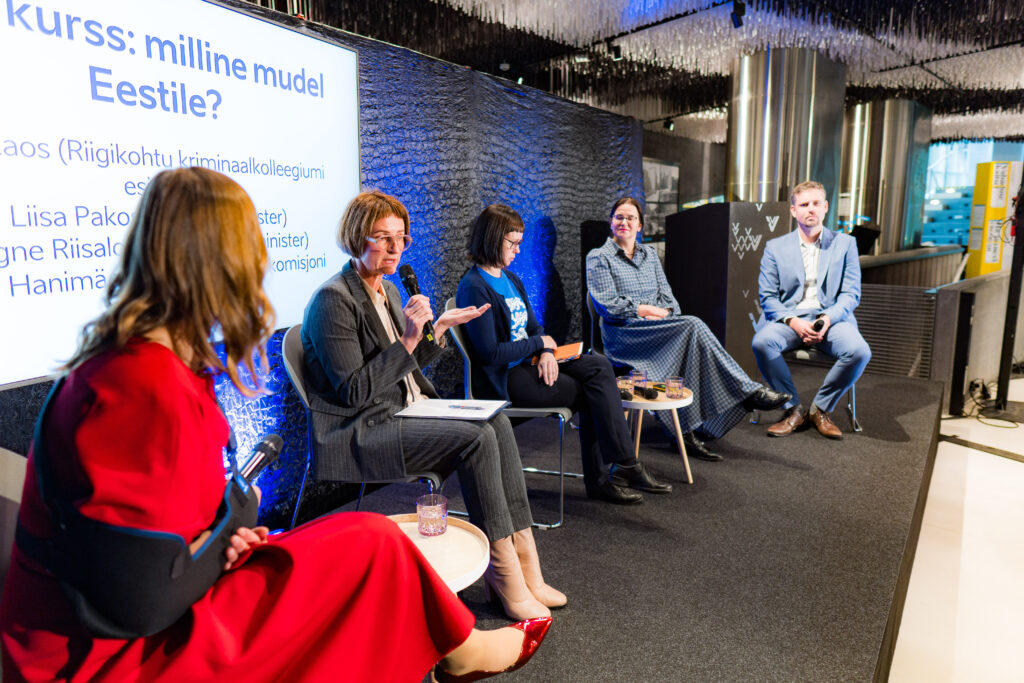
Estonia’s course: which model for Estonia? | On the stage (from the left): Kersti Kaljulaid (former President of Estonia), Signe Riisalo (Minister of Social Protection), Saale Laos (Chairman of the Criminal Chamber of the Supreme Court), Liisa Pakosta (Minister of Justice), Andre Hanimägi (Head of the Committee on Legal Affairs).
Kersti Kaljulaid, who moderated the discussion, enquired from Saale Laos that if the Yes Means Yes model is securely based in human biology and the opinion of doctors, and even the judges are saying that for them there is no difference in which of the claims has to be proven (i.e., proving whether a person gave consent is not procedurally different from proving that they said no), then why is the nature of the model even under discussion. Why is it not already clear that we must proceed with the Yes Means Yes model? The chairperson of the Criminal Chamber of the Supreme Court of Estonia Laos argued that she is not sure which of the models would be better, because neither of them solves all of the issues with meeting the conditions for evidence, which makes it necessary to thoroughly analyze them, distinctly focusing on real life situations and borderline cases.
Liisa Pakosta: “A woman is no worse than a purse!”
The Minister of Justice Liisa Pakosta said that to her as a supporter of the Yes Means Yes model the question seems quite simple. “I’m thinking about it along the following lines – I left my purse on that seat. If someone takes my purse and walks away with it without me offering much resistance, then I think that is not OK. I actually believe that a woman is no worse than a purse!”
According to Pakosta it is important that the law be passed in accordance with the best legislative practice that the society has agreed upon, which includes public discussion, like the current Forum itself. The next step will be the preparation of a legislative intent, which explains the nature of the problem and offers different ways in which to solve it. This means that in the case of consent law, the legislative intent will probably propose versions involving both the No Means No and Yes Means Yes models, charting the advantages, disadvantages, and risk points of the two. Riisalo added that a good legislative intent will give us very clear options. After the Ministry of Justice has proposed different versions, another public discussion is needed, after which a conclusive decision will be made.
Consent must not remain an issue for women only
In addition to those on the stage, the Forum included even more people involved in the subject among the audience. When questions and comments from them were prompted, many very important additions to the issues discussed on the stage were raised. People among the audience pointed out that according to latest polls, 81% of the residents of Estonia believe that if both parties have not given consent, what transpires must be considered rape, confirming Andre Hanimägi’s view that culturally the Yes Means Yes model is already in effect.
Among those speaking out from the audience was the Director General of Estonian Police and Border Guard Board Egert Belitšev, who pointed out that other crimes do not presuppose violence, as additional use of violence is already considered an aggravating circumstance in criminal proceedings. He called for a comparison with legal measures for other crimes, and suggested rape should be dealt with in a similar manner. Belitšev especially emphasized that this is a responsibility for the whole society: “This must not remain an issue for women only!”
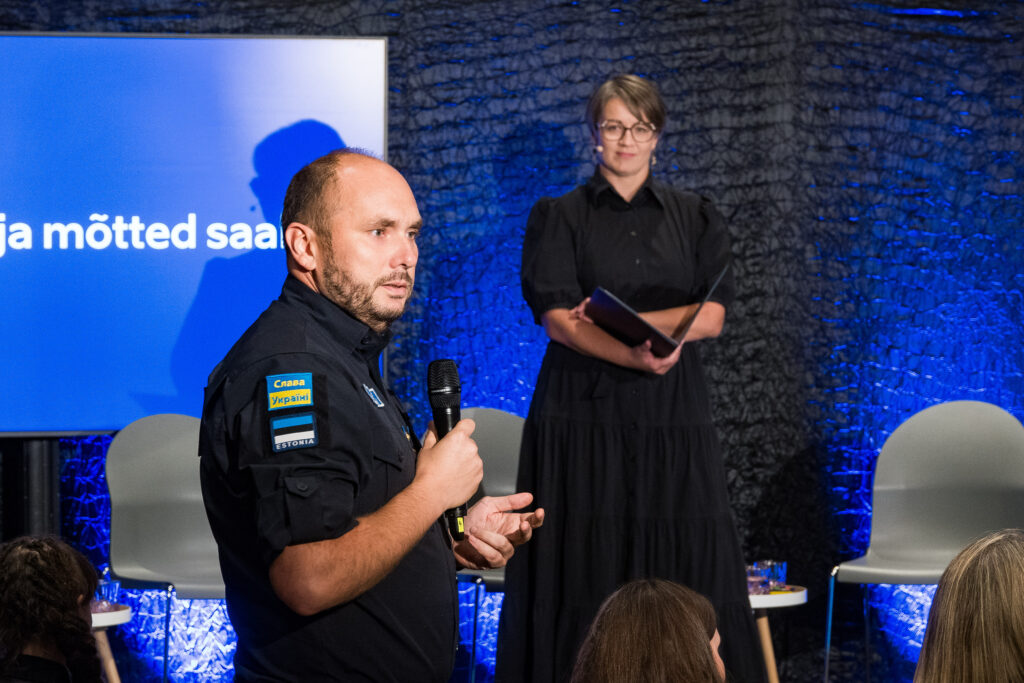
The Chief of Estonian Police and Border Guard Board Egert Belitšev stated that in practice the Yes Means Yes model applies to virtually every other crime besides rape.
Also speaking out from the audience, the Minister of Health Riina Sikkut agreed with many who spoke before her that the Yes Means Yes model is suitable for the legislative space of Estonia, and expressed the belief that this is the only model in accord with healthy and wholesome relationships. On a more pragmatic note she added that affecting any change demands great expenses, and that these expenses and efforts are only justifiable if they help bring about actual change.
